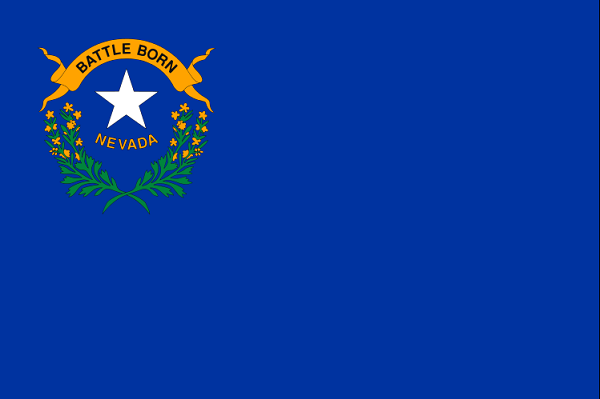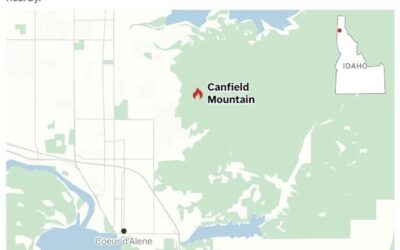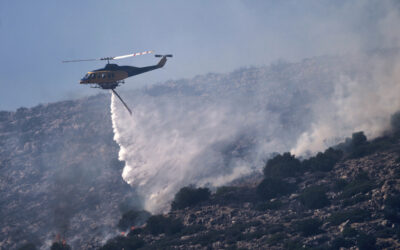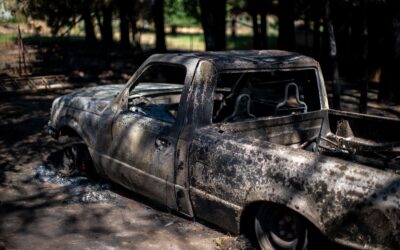“Fire doesn’t really care that there’s a pandemic.”

By SAM METZ AP/Report for America
CARSON CITY, Nev. (AP) — Fire officials preparing for a hazardous wildfire season in Nevada will be challenged by high temperatures, drought and the coronavirus.
“Fire doesn’t really care that there’s a pandemic. We’re going to have to do our job, but we can minimize the risk,” Reno Fire Department Chief Dave Cochran said at a 2020 Fire Season Outlook conference Wednesday.
Cochran, who also serves as Nevada Fire Chiefs Association president, said departments were aware that the virus could spread through their ranks. Firefighters in his department have already contracted it, he said, declining to provide additional details due to privacy concerns.
Due to the nature of their work, firefighters can’t always adhere to CDC guidelines on face-coverings and social distancing when deployed, Cochran said. But his departments and others throughout Nevada are adopting new protocols to test staff for fever and flu-like symptoms before they’re deployed to fire lines, require personal protective equipment and regularly sanitize gear, Cochran said.
To limit interaction with the public, Cochran also plans to restrict his staff from leaving fire camps, for example, to keep them from dining in groups at restaurants.
With heavy fuel loads, dry conditions and above average temperatures, the National Interagency Fire Center projects Nevada and states throughout the U.S. West will face higher wildfire risk than most years as the summer progresses.
In late May, a wildfire engulfed 1,118 acres of the Humboldt-Toiyabe National Forest about 30 miles (48 kilometers) northeast of Ely. More than 140 fires have scorched more than 10,000 acres throughout the Silver State, according to U.S. Forest Service figures.
Officials said this week that it’s only beginning.
“We are looking at a pretty big fire season, Nevada Division of Forestry Firewarden Kacey KC told state lawmakers at a legislative committee hearing this week. “When we saw the seasonal outlook this year, we’re looking at fuel loads of 100 to 300% of our normal carry-over from last year as well as new fuel loads from the spring moisture we received.”
In Nevada, federal agencies — mainly the U.S. Forest Service and Bureau of Land Management — manage most of the land in the sparsely populated rural counties north of Las Vegas, where the recent growth of flammable cheatgrass has created new levels of wildfire risk.
The agencies collaborate under a Shared Stewardship Agreement that Nevada Gov. Steve Sisolak, the Forest Service, BLM and U.S. Fish and Wildlife Services signed in November to plan for wildfire seasons and allocate resources.
Last June, state lawmakers passed a bill to provide the State Department of Conservation and Natural Resources an additional $5 million to fight fires. At a legislative committee hearing Tuesday, they discussed how much to spend on prevention efforts such as fuel reduction and how much to save to suppress fires once they spread.
State Sen. Pete Goicoechea, R-Eureka, said he worried about overspending on prevention due to anticipated coronavirus-related tax revenue loss. When peak season hits, he hopes the state has adequate funds to contain the blazes.
“I’m a little nervous about with the shortfall in the budget and whether we should be moving forward (spending the funds),” he said.
Goicoechea, a rancher who represents vast swaths of rural eastern and central Nevada, also said it was difficult at times for officials to reach agreement on where to focus on fire prevention and fuel reduction efforts.
The state and federal agencies tasked with fighting wildfires, he said, worry about fire erupting near Las Vegas and Reno. But the drought blanketing Nevada’s vast rangelands endangers the region’s cattle ranchers and their ability to make a living.
“I’m just concerned that, in another 30 days, that livestock is going to have to move to higher elevations,” he said. “We will have a tinderbox in the lower elevations.”
___
Sam Metz is a corps member for the Associated Press/Report for America Statehouse News Initiative. Report for America is a nonprofit national service program that places journalists in local newsrooms to report on undercovered issues.
All contents © copyright 2020 The Associated Press. All rights reserved.




